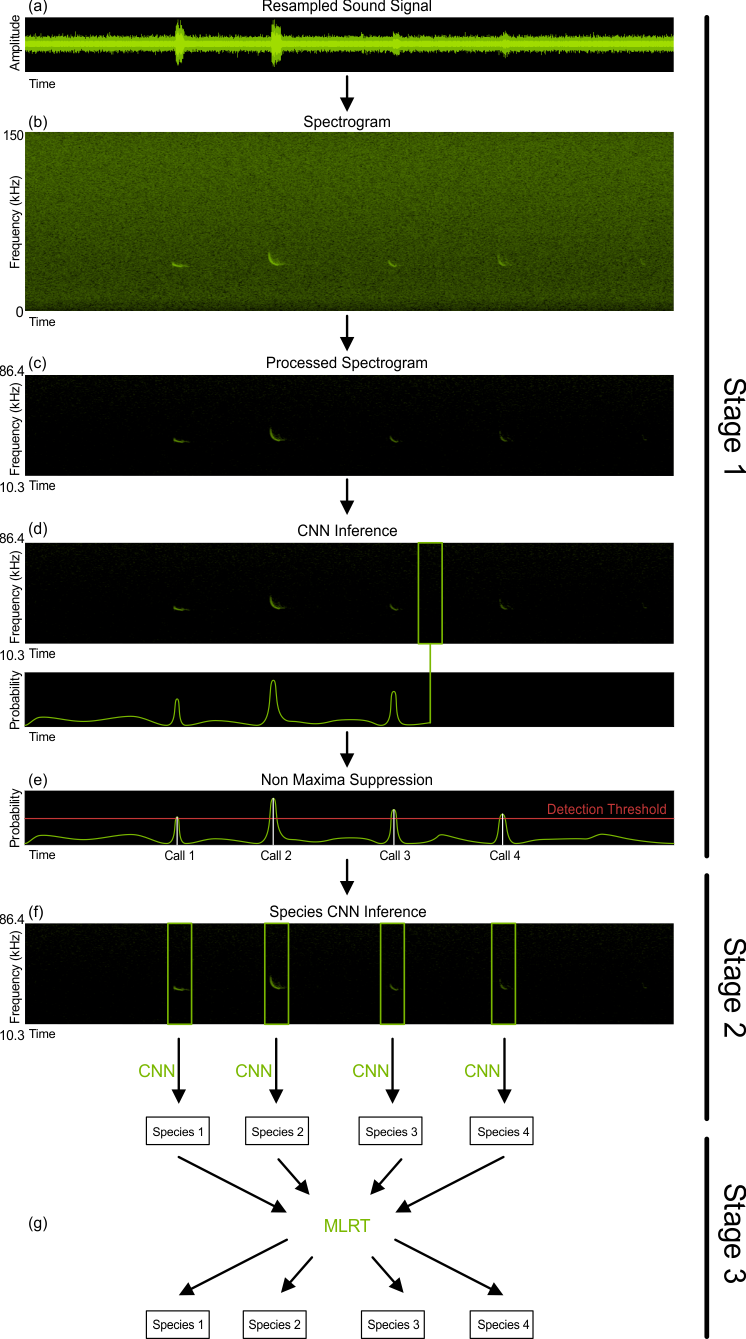04. – 08. April 2022 – Conference on Wind energy and Wildlife impacts (CWW) in Egmond aan Zee, The Netherlands
7. April 2022No power? No problem! With the solar kit for the BATmode System you can now measure everywhere!
4. November 2022We are happy and excited to announce the release of the new BATscreen PRO 3, which will bring a whole bunch of new features. Of course, the focus of BATscreen PRO remains on an intuitive and efficient analysis of bat call recordings. This is the only way to analyse the large amounts of data collected during long-term acoustic surveys, but the new AI Call Detector makes it even easier.
This innovative detector for an automated call detection and species identification is based on a multi-stage combination of Convolutional-Neuronal-Networks (CNNs) and Maximum-Likelihood-Estimates (MLEs). The sequence of a call detection and species identification is illustrated in the adjacent figure. The models used were trained in advance with over 40,000 calls. Thus, it is possible to determine the temporal position of calls with a high accuracy and to subsequently assign them to one of 14 bat species/genus of Central Europe. The detected positions are marked and the suggested species is indicated together with the probability of correct classification. As automated call detection never will be perfect, it is crucial to evaluate the performance of the AI Call Detector for your individual data set in advance of a large data evaluation. For this, BATscreen PRO will support you with its AI Call Detector evaluation method. This way you can find the optimal detector settings and evaluate whether individual noise recordings in you data set are reliably detected. Consequently, time-consuming manual reviews can be reduced or avoided completely.
Furthermore, with the new Labeling-Tool it is now possible not only to assign whole files to one or more bat species, but to mark calls within a file with rectangular bounding boxes and to assign them individually to bat species and call types (e.g. Echolocation, Social, Echo, etc.).
To extend the support of different bat detectors BATscreen PRO now stores all results as so-called GUANO metadata. This format can also be read by other analysis programs and is supported by a wide range of detectors. This allows to also read in header data from Wildlife Acoustics detectors and Audiomoth devices from Open Acoustic Devices.
Since we have invested a lot of development time and money in the further development of BATscreen PRO, we are unfortunately not able to transfer the licenses for the old BATscreen to the new version 3. In order to offer BATscreen PRO at an attractive price and to act more flexibly in the future, we have decided to change the licensing in a subscription model. More information about the new BATscreen PRO can be found here.
[1] The call detection and species classification of the AI Call Detector is divided into three stages:
Stage 1: Call Detection
The sample rate of the audio signal is adjusted to 300 kHz if necessary (a) and the spectrogram is calculated (b). Subsequently, the background noise is reduced by a denoising process and the frequency range is trimmed to the band relevant for bat calls (c). Call detection is now performed by using a "sliding window" to determine the call probability along the time axis using CNN inference (d). At times when the local maximum of the call probability exceeds the detection threshold, a call detection is triggered (e).
Stage 2: Species Identification
A second CNN inference is used to identify the species at the points of call detection (f).
Stage 3: Review of Species Identification
Following this, it is determined whether it can be considered as statistically proven that a specific species occurs in the call file. If not, the next most likely species is assigned to the calls in question (g).

Call Detection and Species Classification with the AI Call Detector [1]

